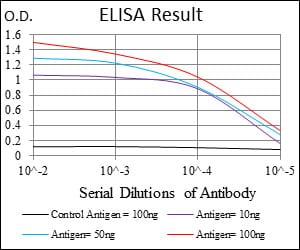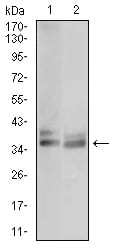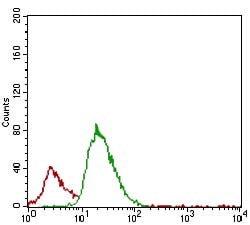


| WB | 咨询技术 | Human,Mouse,Rat |
| IF | 咨询技术 | Human,Mouse,Rat |
| IHC | 1/30-1/150 | Human,Mouse,Rat |
| ICC | 技术咨询 | Human,Mouse,Rat |
| FCM | 咨询技术 | Human,Mouse,Rat |
| Elisa | 1/5000-1/10000 | Human,Mouse,Rat |
| Aliases | TRAP; SPENCDI |
| Entrez GeneID | 54 |
| clone | 5C5E7 |
| WB Predicted band size | 36.6kDa |
| Host/Isotype | Mouse IgG1 |
| Antibody Type | Primary antibody |
| Storage | Store at 4°C short term. Aliquot and store at -20°C long term. Avoid freeze/thaw cycles. |
| Species Reactivity | Human |
| Immunogen | Purified recombinant fragment of human ACP5 (AA: 221-325) expressed in E. Coli. |
| Formulation | Purified antibody in PBS with 0.05% sodium azide |
+ +
以下是关于TJP1(ZO-1)抗体的3篇代表性文献,涵盖其功能研究和应用场景:
---
1. **文献名称**:*ZO-1 and ZO-2 Independently Determine Where Claudins Are Polymerized in Tight-Junction Strand Formation*
**作者**:Umeda, K., et al.
**摘要**:该研究通过基因敲除小鼠模型和免疫荧光技术,发现ZO-1和ZO-2蛋白在调控紧密连接(Tight Junction)中claudin蛋白的聚合定位中起独立作用。研究使用TJP1抗体验证ZO-1在细胞极性形成中的关键功能,揭示其在细胞屏障完整性中的机制。
---
2. **文献名称**:*Direct Binding of Three Tight Junction-Associated MAGUKs, ZO-1. ZO-2. and ZO-3. with the COOH Termini of Claudins*
**作者**:Itoh, M., et al.
**摘要**:本文通过免疫共沉淀和Western blot技术,证明ZO-1(TJP1)与claudin蛋白的C端直接结合,参与紧密连接的结构组装。研究利用特异性TJP1抗体阐明其在细胞间连接中的分子互作网络,为屏障功能研究提供依据。
---
3. **文献名称**:*Loss of the Tight Junction Protein ZO-1 in Breast Cancer Correlates with Epithelial-Mesenchymal Transition and Tumor Metastasis*
**作者**:Martin, T.A., et al.
**摘要**:通过免疫组化分析乳腺癌组织样本,研究发现ZO-1表达下调与上皮-间质转化(EMT)及肿瘤转移显著相关。研究利用TJP1抗体检测蛋白表达水平,提示其作为癌症预后生物标志物的潜力。
---
如需更多文献或具体应用方向(如神经、肠道屏障等),可进一步补充说明!
TJP1 (Tight Junction Protein 1), also known as Zonula Occludens-1 (ZO-1), is a critical scaffolding protein localized at cellular tight junctions, specialized structures that regulate paracellular permeability and maintain cell polarity in epithelial and endothelial tissues. It belongs to the membrane-associated guanylate kinase (MAGUK) family, characterized by PDZ, SH3. and GuK domains that mediate interactions with transmembrane proteins (e.g., claudins, occludin) and cytoskeletal components. TJP1 plays a vital role in organizing tight junction assembly, signal transduction, and barrier integrity.
TJP1 antibodies are essential tools for studying tight junction dynamics in physiological and pathological contexts. They are widely used in techniques like immunofluorescence, Western blotting, and immunohistochemistry to visualize TJP1 distribution, quantify expression levels, or assess junctional integrity in diseases such as cancer, inflammatory bowel disease, and skin disorders. Altered TJP1 expression or localization is associated with epithelial-mesenchymal transition (EMT), metastasis, and barrier dysfunction. Researchers also utilize these antibodies to explore therapeutic interventions targeting junctional stability or to validate in vitro models of epithelial barriers. Commercially available TJP1 antibodies are typically raised against specific epitopes (e.g., human C-terminal regions) and validated for cross-reactivity in common model organisms. Proper controls are crucial due to potential isoform variability and post-translational modifications affecting antibody specificity.
×